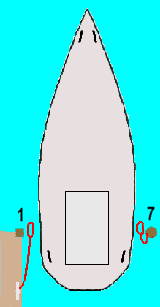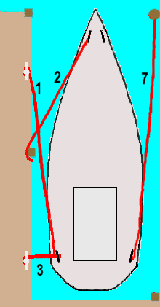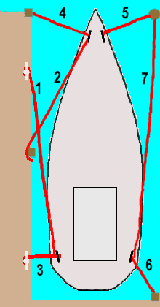
Sailing the Catalina 320 Single Handed
~~ Paul V. Hartman ~~
Part III - Returning to Berth
Within visual range of your anchorage, furl the genoa. When nearer, start the engine, turn into the wind, tension the lazy jacks, brake the wheel, and lower the main. Put sail ties on the main, set out dock lines and fenders. You may want to open the life lines on the side corresponding to your dock. Have your boat hook handy. Hail the harbor master if that is the procedure where you berth. Proceed to your berthing location.
If You Use an Anchorage Buoy
The easy trick may be to attach a temporary line from a bow cleat and run it to the cockpit (outside the life lines)with a snap hook or shackle on the cockpit end. Head upwind into the buoy and allow the boat to drift by the buoy so that you can lean out from the cockpit, grab the buoy pendant and hook the shackle to it. Allow the boat to drift backward as you walk to the bow, draw in on that line, and swap the temporary line for your usual tie-up line.
If You Use a Dock
My personal preference is to stern-in. I learned to stern-in during my introduction to the 320, and I have insisted on it ever since. It is only a little more difficult, there are some advantages, and it garners points in the marina, since no one else is likely to be doing it at 32 feet and longer. (Notice that many larger power boats are stern to the dock.) Definitely consider stern-in if it puts your bow pointing into the direction of the most frequent larger storms.
Success flows from preparation. Dock lines of measured length, left on the dock, will facilitate re-entry. As mentioned previous, I have two lines which run from forward pilings to stern cleats, one on each side. Each is left on the piling in an easy-to-grab position awaiting my return - readily reached from my position at the helm as the stern passes either piling. (In my case a boat hook is not required to reach them.)
 |
| Figure 4 |
It does not matter which I can reach - port or starboard. As I back in and pass the piling at the front of the berth, I grab the one closest to hand, slip it over the stern cleat, and my trouble is half over, as the stern cannot now collide with the dock. At that point I kill the engine with the boat drifting aft.
Figure 4 illustrates the C320 as the stern approaches either of the pilings at the front of the berth. In point of fact, I have time to grab both of them, as the sterning-in is conducted slow enough to do so.
Referring again to dock line 2, (the only one I took with me), it was retrieved from the anchor well (at the time that fenders were being set out) and the loop placed over the bow cleat on the port side, then led to the cockpit outside the lifelines, then wrapped on the genoa winch. I pick up this line and the boat hook and jump to the dock. (Usually the 320 is still drifting slowly aft when I do so.)
This line is belayed to any convenient dock cleat or piling. As this action prevents forward motion, and the stern line prevents aft motion, the boat is secure, and any other lines I set are simply tweaking my position.
 |
| Figure 5 |
Figure 5 reveals that the 320 has drifted back, setting lines 1 and 7 taut. Line 2 is wrapped on a piling, and I have next slipped a short double looped line (3) over a stern cleat to prevent my boat from gliding over to my neighbor's boat to starboard.
I now add the remaining corners, 4,5,6, always leaving the boat in anticipation of a hurricane. Fenders which were deployed in anticipation of docking are now examined to see if any need be moved as protection for conditions at the dock.
 |
| Figure 6 |
Figure 6 shows me back where I began. 7 lines out, because this boat lives in hurricane country.
I have not described using the boat hook when coming or going, though I have mentioned on several occasions keeping it handy. If I am on the boat, the boat hook is on the boat. If I am on the dock, the boat hook is on the dock.
If you prefer to berth bow-in, the principles are the same. Leave dock lines on forward pilings which you can grab as the helm position passes by the forward pilings, and attach them to stern cleats. You will appreciate that when sterning in, that maneuver occurs early in the docking procedure, whereas docking bow-in, the maneuver occurs late. In either case, the success of the maneuver is immensely facilitated by the fact that you are leaving dock lines on the dock which are known to be measured exactly, and to fit correctly.
Three-strand nylon dock lines are $20 each for 5/8 inch, 40 feet long. You can afford to have measured lines left at the dock while taking a few 35-40 footers with you for other situations.
Leaving the Boat After Sailing
If you return hot and/or tired from your sailing adventure, it is easy to forget something. Here is your checklist:
1. Check dock lines and fenders again to be sure nothing is amiss.
2. Stow cockpit cushions, life jacket, and other materials while retrieving canvas covers. Stow the boat hook.
3. Detach the main halyard from the mainsail and attach it to the starboard shroud cleat provided by Catalina. Take down the starboard pennant if one is flying.
4. Loosen lazy jack lines, then replace the mainsail cover.
5. Check all lines going to the cockpit for proper tension; close all rope clutches. Tidy up the free ends of halyards and lines from topping lift, vang, etc.
6. Retrieve the engine key from the helm, store your binoculars, hand VHF, etc. from the helm, set your wheel straight, and cover the wheel and binnacle.
7. Store the stern flag if you used one.
8. Retrieve your shore power cord if you use one; hook up and check proper switches.
9. Below, switch off all electronics except the bilge, set to automatic. Set your battery switch to either 1 or 2 using some routine such as 2 on even days.
10. If you close sea cocks, do it now.
11. Inspect the head to see that all is normal. Inspect the bilge to see that all is normal.
12. Remove any food not intended to stay on board.
13. Check again that no ports or hatches are open. (Don't forget the little one in the head!) Take the companion-way boards from their pocket and pass them up to the cockpit. Check to see that you have your car keys. Grab your gear bag and leave the cabin.
14. Close up and lock the companionway; lock the cockpit lockers.
15. Go to the dock with your gear bag; close the life lines.

Go on to Part IV: Miscellaneous Notes 

|